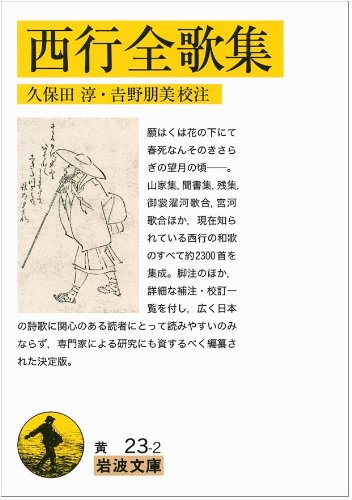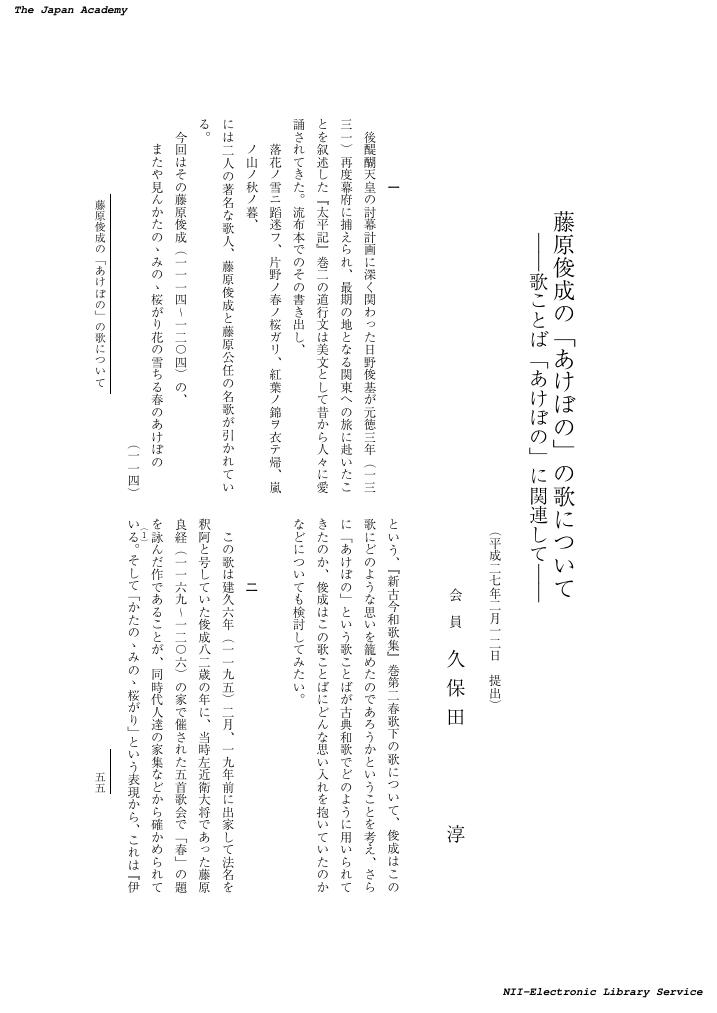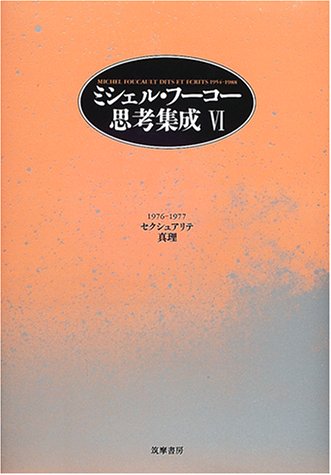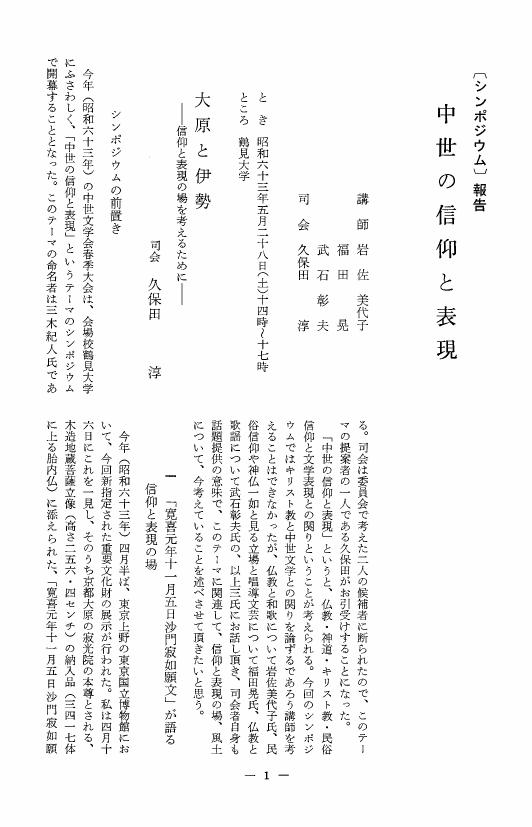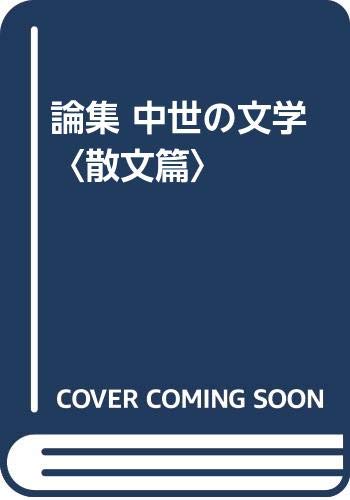13 0 0 0 OA 西行試論
- 著者
- 久保田 淳
- 出版者
- 日本学士院
- 雑誌
- 日本學士院紀要 (ISSN:03880036)
- 巻号頁・発行日
- vol.78, no.1, pp.21-38, 2023 (Released:2023-11-22)
In his work An Introduction to the History of Japanese Literature, Kato Shuichi observes that Saigyo's waka poetry communicates his emotions and experiences in a simple and direct language, which differs from the technical style of Fujiwara no Teika, an important poet in the Shinkokin Wakashu. At the same time, Kato argues that several of Saigyo's poems address the topic of kachofugetsu (“the beauty of nature”), which is the central theme of the aristocratic culture, similar to the poems written by court intellectuals in the Heian era; according to Kato, Saigyo submitted to this elite culture. In this essay, the author first questions this criticism of Saigyo, emphasizing the unique consideration of natural phenomena and ordinary lives in his poems and discussing the diversity of his writing by citing his works on natural phenomena, such as lunar eclipses and rainbows, and his poems about thieves—topics that did not interest poets before him. The essay notes that Saigyo enjoyed writing haikai verses, which were regarded as somewhat inferior “miscellany” poems in the Kokin Wakashu, and renga, which poets had composed as a hobby since the late Heian period, and considers the nature of the humor in these poems to emphasize Saigyo's critique of society. (View PDF for the rest of the abstract.)
9 0 0 0 OA 後鳥羽院の『時代不同歌合』と藤原定家の『百人秀歌』
- 著者
- 久保田 淳
- 出版者
- 日本学士院
- 雑誌
- 日本學士院紀要 (ISSN:03880036)
- 巻号頁・発行日
- vol.76, no.1, pp.1-19, 2021 (Released:2021-11-20)
The widely-held notion that Hyakunin isshu (“One Poem Each by One Hundred Poets,” also Ogura hyakunin isshu) represented an anthology of waka poems chosen by Fujiwara no Teika for their particular excellence—until then almost an axiom—was shaken in the early 1950s by the discovery of another collection of outstanding poems called Hyakunin shūka (“Poems of Excellence by One Hundred Poets”). Hyakunin isshu is a miniature anthology containing 100 waka poems of excellence by one hundred different poets, beginning with works by Emperor Tenji and Empress Jitō and ending with works by Go-toba and Juntoku, two retired emperors condemned to exile on remote islands after the Jōkyū Disturbance. In the work Hyakunin shūka, by contrast, these final poems by the two retired emperors are missing, with works by the Ichijōin Empress and two others in their place for a total of 101 poems in all. Various theories have been advanced to explain this difference: one theory sees Hyakunin shūka as likely an earlier, draft version of Hyakunin isshu; another theory—assigning with high confidence the compilation of Hyakunin shūka to Teika himself—ascribes the replacement and reordering of poets and poems within Hyakunin isshu instead to Tameie, Teika's son. As such, the identity of Hyakunin isshu's compiler remains, even today, a problem not yet unambiguously resolved. (View PDF for the rest of the abstract.)
5 0 0 0 西行全歌集
- 著者
- [西行著] 久保田淳 吉野朋美校注
- 出版者
- 岩波書店
- 巻号頁・発行日
- 2013
5 0 0 0 西行全歌集
- 著者
- [西行著] 久保田淳 吉野朋美校注
- 出版者
- 岩波書店
- 巻号頁・発行日
- 2018
5 0 0 0 OA 「すきま」の美意識について
- 著者
- 久保田 淳
- 出版者
- 日本学士院
- 雑誌
- 日本學士院紀要 (ISSN:03880036)
- 巻号頁・発行日
- vol.73, no.3, pp.139-150, 2019 (Released:2019-04-12)
My hypothesis that there is some connection between “ma” (space or pause),which has been considered important in classical Japanese literature and arts, and “yūgen” (ethereal beauty), an often-discussed aesthetic principle thereof. To prove this hypothesis, I examined what interests the authors have in “sukima”, a form of “ma”, how effectively they express it, and what intentions they have, using waka poems, karon (poetic treatises), and monogatari (narratives) as examples. The works I cited are as follows: waka poems from the Man’yōshū, waka poems composed by poets of the Heian period, Genji monogatari (The Tale of Genji), Mumyōshō (a poetic treatise by Kamo no Chōmei), Tsurezuregusa (Essays in Idleness, a collection of essays by Yoshida Kenkō), and Kosunoto (a jiuta song of the Edo period). Furthermore, I introduced the criticisms made by Masaoka Shiki in his Utayomi ni atauru sho (Letters to a Tanka Poet), and the examples of usage of the word “yūgen” in Natsume Sōseki’s novel Kusamakura. Also, I argued that there is a connection between “yūgen” and “iki”, an aesthetic principle of early-modern Japanese literature and arts advocated by philosopher Kuki Shūzō in his book “Iki” no kōzō (The Structure of “Iki”), although the two notions appear to be quite distant from each other.
2 0 0 0 OA 岩波講座日本文学史
- 著者
- 久保田淳 [ほか]編
- 出版者
- 埼玉県立久喜図書館
- 巻号頁・発行日
- vol.第10巻 (19世紀の文学), 1996
2 0 0 0 OA 藤原俊成の「あけぼの」の歌について : 歌ことば「あけぼの」に関連して
- 著者
- 久保田 淳
- 出版者
- 日本学士院
- 雑誌
- 日本學士院紀要 (ISSN:03880036)
- 巻号頁・発行日
- vol.70, no.1, pp.55-70, 2015 (Released:2017-04-05)
2 0 0 0 OA かな漢字変換における誤入力の訂正
- 著者
- 山本 喜大 久保田 淳市 庄田 幸恵 白井 豊
- 雑誌
- 情報処理学会研究報告自然言語処理(NL)
- 巻号頁・発行日
- vol.1997, no.109(1997-NL-122), pp.105-111, 1997-11-20
日本語の入力操作全体での効率向上のために、かな漢字変換上に誤入力を訂正する機能を試作した。本かな漢字変換は、置換、挿入、脱落誤りのいずれかを一つ含む文節を訂正する。ユーザの訂正指示操作に応じて複数の誤り訂正候補を提示しユーザが選択する方法(選択型訂正)と、変換操作に応じて自動的に誤りを訂正する方法(自動訂正)の2つのインターフェースを想定し性能を評価した。実験の結果、選択型訂正の再現率は第1位が39%、上位6位までで59%であった。また自動訂正の再現率は4%、誤り率は3%であった。
2 0 0 0 OA 平安・鎌倉時代における二、三の名所について
- 著者
- 久保田 淳
- 出版者
- 日本学士院
- 雑誌
- 日本學士院紀要 (ISSN:03880036)
- 巻号頁・発行日
- vol.66, no.3, pp.115-129, 2012-03
- 著者
- 久保田 淳
- 出版者
- 一般社団法人日本機械学会
- 雑誌
- 年次大会講演資料集
- 巻号頁・発行日
- vol.2005, no.8, 2005-09-18
1 0 0 0 徒然草評釈-83-年々の春の草のみぞ
- 著者
- 久保田 淳
- 出版者
- 学灯社
- 雑誌
- 国文学 解釈と教材の研究 (ISSN:04523016)
- 巻号頁・発行日
- vol.31, no.8, pp.p146-148, 1986-07
1 0 0 0 OA 源氏物語はなぜ読まれるのか
1 0 0 0 セクシュアリテ/真理 : 1976-1977
- 著者
- ミシェル・フーコー [著] [久保田淳ほか訳]
- 出版者
- 筑摩書房
- 巻号頁・発行日
- 2000
1 0 0 0 OA 報告 中世の信仰と表現
- 著者
- 久保田 淳
- 出版者
- 一般社団法人 日本機械学会
- 雑誌
- 年次大会講演資料集
- 巻号頁・発行日
- vol.2005, 2005
1 0 0 0 係り受け解析のための辞書の構成とその学習機能
- 著者
- 白井 克彦 林 良彦 平田 裕一 久保田 淳市
- 出版者
- 一般社団法人情報処理学会
- 雑誌
- 情報処理学会論文誌 (ISSN:18827764)
- 巻号頁・発行日
- vol.26, no.4, pp.706-714, 1985-07-15
- 被引用文献数
- 3
日本語文の構造は 文の構文的・意味的な構造に大きく関わっている.よって 日本語文の処理を行う場合 その係り受け構造を明らかにすることが重要である.計算機により日本語文の係り受け解析を行う研究は広く行われているが そのために必要な知識の獲得・構造化を半自動的にかつ適応的に行うための研究は少ないように思われる.本論文では テキストデータに対する分析から直接的に以後の成長の核となる初期辞書データベースを構成する方法 および成長のための学習機能について検討した.この辞書データベース中では 単語はその係り受け特性に基づいてクラスタリングされ 分析対象としたテキスト中の単語間の係り受け関係は クラスタ間の係り受け可能関係として抽象化されて記述される.本辞書データベースは 実験文解析システムESSAYによる文解析に適用され その評価を受ける.さらに 解析が不成功である文において そのネガティブな状況より獲得される情報を用い 学習構造化の処理を受ける.このように 言語要素(単語等)の使われ方に基づいて知識の獲得を行うため 対象世界における拘束を緩やかに含んだ形の知識を得ることができる.また辞書データベースという記述的な形で構造化を行うため それ自身インクリメンタルに成長することが可能となった.
1 0 0 0 怨み深き女生きながら鬼になる事--「閑居友」試論
- 著者
- 久保田 淳
- 出版者
- 岩波書店
- 雑誌
- 文学 (ISSN:03894029)
- 巻号頁・発行日
- vol.35, no.8, pp.44-55, 1967-08
